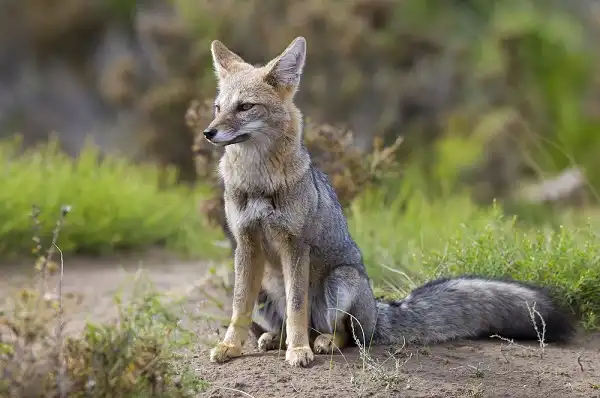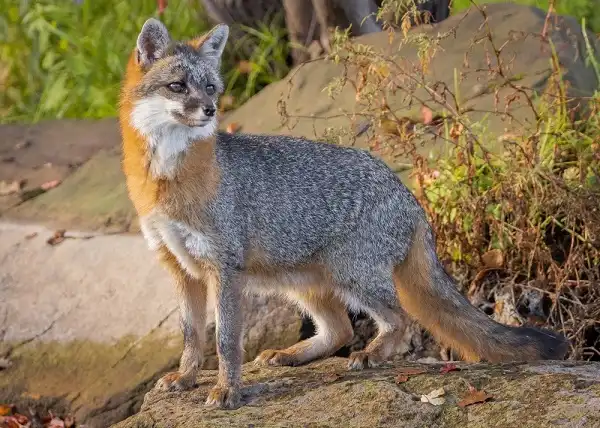As an iconic member of the canine family, gray foxes are some of the most beautiful and intelligent creatures in nature. Often mistaken for their larger cousin, red foxes, these small predators have adapted to a wide range of habitats around the world. Gray foxes can be found living in forests, deserts, and even urban areas – making them true survivors when it comes to adapting to different environments. Homeowners may find themselves being lucky enough to spot one sneaking around their yard or peeking through a fence as they search for food through dumpsters and garbage cans. This blog post will dive into all there is to know about this impressive animal; from its behavior traits and excellent agility, down to its diet and habitat needs. Get ready to learn all you need to learn more about your potential new neighbor!

Gray Fox Description
The gray fox is a small, slender member of the canine family. Its fur is typically grizzled gray, with rust-colored fur along its back and sides. Its tail is bushy and tipped with black, and its face has a characteristic black mask around the eyes. Gray foxes are known for their agility and intelligence; they are able to climb trees vertically, using their sharp claws for traction. They also possess the ability to jump up to 10 feet from the ground onto low branches or fences.
Gray Fox Habitat
The gray fox is a highly adaptable species, able to occupy a wide range of habitats around the world. They can be found in forests, deserts, and even urban areas; however, they prefer environments with thick vegetation for cover when hunting. In North America, their preferred habitat is deciduous or mixed woods with an understory of shrubs and vines. They may also inhabit grasslands, scrublands, chaparral, and other areas where there is dense ground cover. Gray foxes are also known to seek shelter in human-made structures such as barns and sheds during cold weather. They often dig dens in the ground around trees or rocks for protection from predators and extreme temperatures. These dens may be reused over several years as long as food sources remain plentiful.
Gray Fox Diet
The gray fox is an omnivorous animal, meaning that their diet consists of both plant matter and animals. In terms of animals, they consume small mammals such as rabbits, rodents, birds, reptiles, and insects. They also feed on fruits and berries when they are seasonally available. In addition to these primary sources of food, gray foxes also hunt for birds’ eggs or scavenge the remains of dead animals if needed. Their sharp claws allow them to easily climb trees in search of food and escape predators. Gray foxes possess a specialized adaptable digestive system that helps them process the diverse range of foods they eat. They can extract nutrients from fruits and vegetables as well as meats – making sure they never go hungry even in times of scarcity.

Gray Fox Size
The gray fox is a mid-sized canine, typically measuring between 24 and 44 inches in length and weighing between 5 and 15 pounds. They have a distinctive reddish-brown coat with white fur along the throat and underbelly, as well as a bushy black-tipped tail. Their size makes them particularly agile, able to climb trees and navigate narrow spaces quickly. Gray foxes have relatively short legs compared to other canines, making them faster runners but slower hikers. They also possess sharp claws which allow them to easily scale vertical surfaces such as rocks or trees when trying to escape predators or get food from higher locations. When fully grown, the gray fox is larger than their cousin, the red fox. However, their size advantage doesn’t make them any less vulnerable; they must still rely on their agility, intelligence, and cunning behavior to stay safe and survive in the wild.
Gray Fox Lifespan
The average lifespan of a gray fox in the wild is around 3 to 6 years, although they have been known to live up to 8 years or more. Healthy gray foxes can reach sexual maturity around 6 months of age, which is when they typically begin to disperse from their family group and look for mates. In terms of predators, the main risks for a gray fox are coyotes, bobcats, and owls. Wolves have also been known to hunt them, though this is far less common and usually occurs only in areas where wolf populations overlap with those of the gray fox. Environmental factors play an important role in a gray fox’s lifespan as well; they tend to be more successful in habitats with abundant food sources and minimal human interference. Overall, gray foxes are resilient creatures that can survive in many different environments. They adapt quickly to changes and use their agility and intelligence to stay safe from predators or find food sources when needed. With proper protection from human interference and ample food sources, these majestic animals can live comfortable lives that span several years in the wild.

Gray Fox Behavior
The gray fox is an incredibly intelligent and adaptable creature, capable of surviving in a wide variety of habitats. They are usually solitary animals that spend most of their day searching for food and shelter with occasional breaks to rest or socialize. Gray foxes are mostly nocturnal, meaning they become active at dusk and remain active until dawn. During the day, they sleep in dens – typically found in hollowed logs or bushes – to stay safe from predators. At night, they begin foraging for food which includes small mammals, insects, fruits, and vegetables. In terms of social behavior, gray foxes typically live alone but may form pairs during the winter months for warmth and protection against predators. When threatened, they may make use of their sharp claws as a defense mechanism rather than fleeing the area like other species. Overall, gray fox behavior is highly adaptive; allowing them to survive in numerous different habitats around the world while avoiding predation by larger animals such as bears and wolves. Their agility and cunning nature have enabled them to remain resilient even in heavily altered ecosystems where humans have drastically impacted their environment.
Gray Fox Speed
The gray fox is an incredibly agile and fast animal, capable of reaching speeds over 40 miles per hour. This impressive speed allows them to quickly and easily escape predators, forage for food, and travel long distances in search of new habitats. Additionally, their powerful back legs enable them to jump from high places; allowing them access to shelter or resources that would otherwise be inaccessible. Their agility is further enhanced by their ability to climb trees, which is a behavior that other fox species cannot do. This allows the gray fox to get away from large predators on the ground and seek refuge above in the safety of tree branches and other foliage. The gray fox’s superior agility and speed are particularly useful when avoiding danger or searching for food. They can easily run through thick underbrush with ease thanks to their long legs and flexible coat of fur.
Gray Fox Hunting
Gray fox hunting is an instinctive behavior that allows the animal to survive and find food in a wide variety of habitats. Typically, they will hunt alone or in pairs with one acting as a lookout while the other searches for food. They primarily feed on small mammals such as mice, voles, rabbits, and squirrels, as well as insects, fruits, and vegetables. Unlike some other fox species like red foxes which actively pursue their prey, gray foxes tend to rely more on stealth and ambush tactics when hunting. This involves silently stalking their prey until they are within striking distance before pouncing with remarkable speed and accuracy. Gray foxes have also been observed using vocalizations to draw out potential prey from their hiding places. In addition to their keen senses of smell, hearing, and vision, these animals use scent marking to identify other individuals’ territories; increasing the likelihood of successful hunts.

Conclusion
The gray fox is an incredibly adaptable species found all over the world. With their agility and cunning nature, they have been able to survive in a variety of habitats while avoiding predation by larger animals. Their impressive speed and climbing abilities have allowed them to quickly escape danger or search for food with ease. Additionally, their hunting skills rely on both stealth and vocalization to successfully capture prey. All of these traits combined make the gray fox one of nature’s most resilient survivors even amid drastic changes to its environment caused by humans. Thus, it is easy to see why this animal has been so successful in surviving numerous environments across the globe.
Frequently Asked Question

